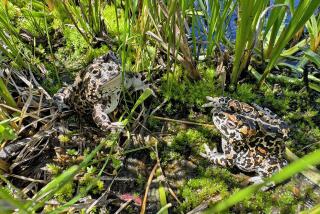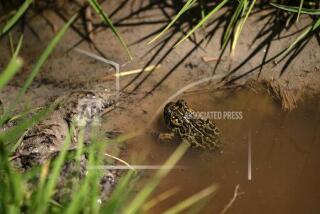ENVIRONMENT / THE TOAD MENACE : Aussies’ Control Plan Backfires
- Share via
BRISBANE, Australia — It seemed like a good idea at the time.
It was 1935, and grayback beetles were ravaging northeast Australia’s vast sugar cane fields. So an enterprising entomologist named Reg Mungomery imported a crate of 101 tropical toads called Bufo marinus from Honolulu.
Mungomery said that the toads would eat the bugs. He forgot one thing: Beetles fly; toads don’t.
Today, while insecticides control the beetles, nothing stops the toads. In a classic case of science gone awry, millions of softball-sized, poison-spitting, sex-crazed cane toads have invaded Brisbane, Australia’s third-largest city, and millions more are shuffling their way down the east coast.
“Nothing can stop them,” said Dr. Glen Ingram, senior curator of vertebrate zoology at the Queensland Museum. “It’s such a tragedy.”
It may sound like a bad horror film, but many here aren’t laughing. Cane toads will eat almost anything, from native frogs to bees. And since the toads are poisonous, almost nothing will eat them.
“It’s a bloody disaster,” said Mike Tyler, a toad specialist at Adelaide University. “A large number of native animals are being simply wiped out.”
Toxic toads are only part of Australia’s growing ecological problems. At least 26 species of “alien” animals are devastating the arid outback, wreaking havoc with native fauna and threatening to change forever parts of the harsh but delicate environment.
“The whole history of introduced animals to Australia has been a disaster,” said Robert Endean, associate professor of zoology at the University of Queensland. “And it isn’t over.”
Endean, a toxicologist by training, said the toads’ venom contains at least 15 toxins, including cardiotoxic bufotenine. He said a student in Sydney drank a “cocktail” of cane toad eggs on a bet last year and survived, but suffered four heart attacks.
Given a puddle and warm weather, a female cane toad can lay 40,000 eggs three times a year. That’s if she survives; males often drown the female while mating. In Central America and the Caribbean, snakes and other local predators keep native toads in check. No such natural predator has emerged in Australia. The toads grow to be 9 inches long and weigh up to 4 pounds.
“It’s big, it’s strong, it’s armored, it resists desiccation, it’s deadly poisonous, it kills things that eat it,” Ingram, the museum curator, said. “How do you fight back?”
Tall tales about toads have spawned a popular film. And a Shanghai-based group is importing freeze-dried venom for possible use in Chinese medicines. The toad has spread nearly 2,000 miles and is now established in half of Queensland, Australia’s giant northeastern state. Moving about 17 miles a year, cane toads are breeding their way south toward Sydney and other urban centers.
Going against the tide, Philip Pickersgill, 51, has taken the toads to heart. He is owner of a Brisbane medical supply company and the chairman and spokesman for the Australian Cane Toad Society.
“Just because they’re ugly, people think they can abuse them, run them over and sell them as paperweights,” he said. “Toads have feelings too.”
More to Read
Sign up for Essential California
The most important California stories and recommendations in your inbox every morning.
You may occasionally receive promotional content from the Los Angeles Times.














